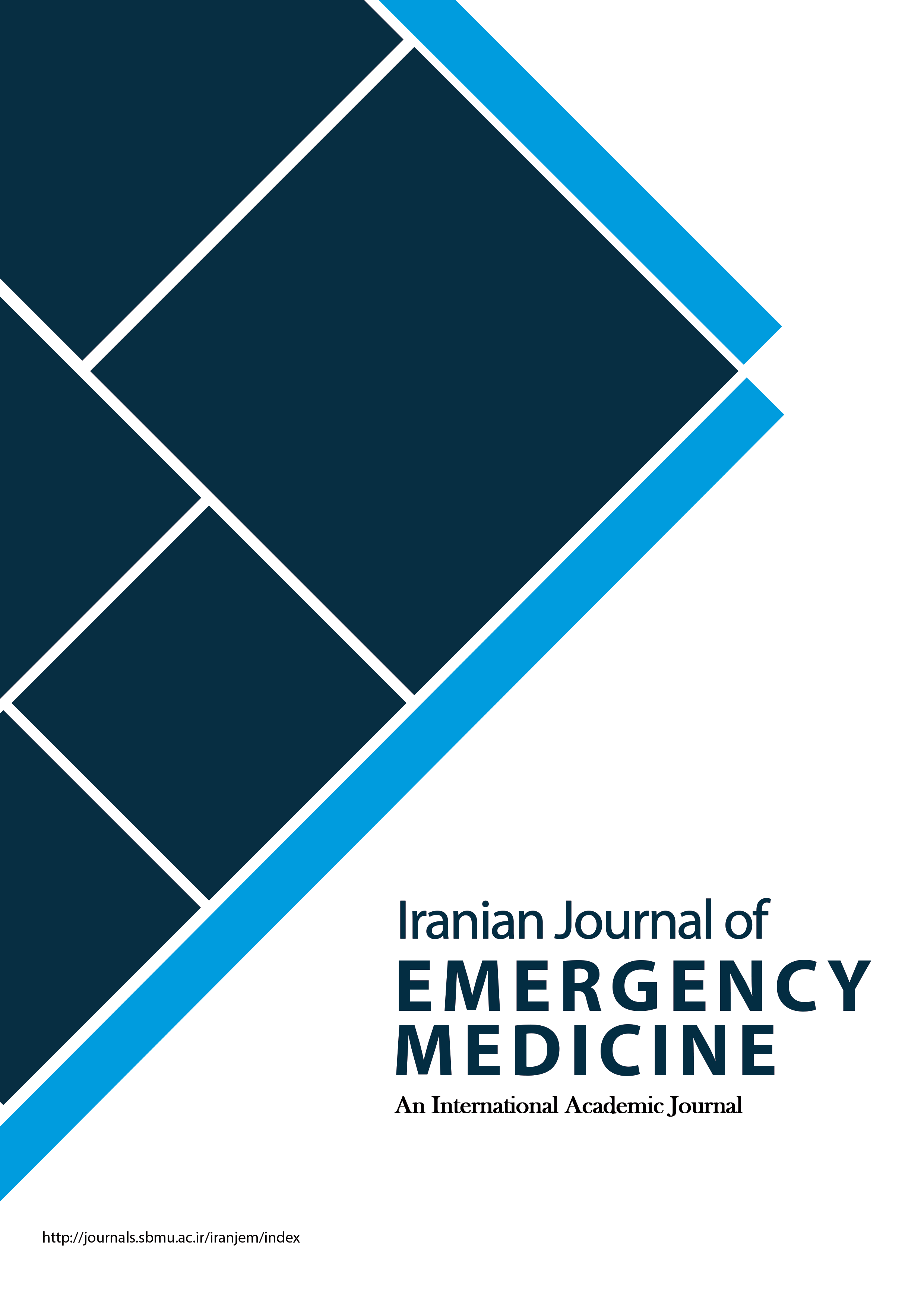Evaluating Benefites and Disadvantages of Care Transition in Emergency Departments in Tehran
Iranian Journal of Emergency Medicine,
Vol. 9 No. 1 (2022),
16 March 2022
,
Page e34
https://doi.org/10.22037/ijem.v9i1.39127
Abstract
Introduction: Field and clinical studies show that care transition after the relevant service is determined is one of the ways to deal with overcrowding in the emergency room. In addition, this method will reduce the workload of emergency physicians and even other personnel such as nurses and assistant nurses. However, some physicians believe that due to legal aspects, transition of patients’ care is not a suitable option. Because of the importance of this issue in managing the emergency rooms all over Iran and improving the quality of the services provided, and also, due to the lack of any study on the advantages and disadvantages of care transition, this research was conducted.
Methods: This qualitative content analysis study was conducted in 2020-2021 to investigate the advantages and disadvantages of patient care transition in emergency rooms in Tehran. 17 experts and medical managers at the Ministry of Health, university, and hospital levels and experts in emergency medicine were interviewed and asked to explain their opinions in this regard in a semi-structured interview. All the interviews were recorded with the permission of the participants and their text was transcribed verbatim and analyzed by the researchers using the content analysis method.
Results: In the present study, 423 initial codes were extracted in the initial analysis, and after removing duplicate codes, the number of final codes reached 218. After reviewing and analyzing the data, advantages, and disadvantages were categorized into three main categories. Also, the benefits included 3 categories and 10 sub-categories. Patients’ status category (3 subcategories of patient care services, patient hoteling, medical errors), physicians’ status category (3 subcategories of physicians’ accountability, impact on the practical experience of physicians, physicians’ differences), and emergency department management category (occupancy of beds, emergency department income, educational opportunities for Emergency medicine, management of emergency medicine).
Conclusion: According to the studies and analyses performed, care transition has more disadvantages from the viewpoint of emergency medicine and affects the management and performance of the emergency department, the performance of physicians and residents, and the condition of patients. Considering the significant disadvantages of this process and the decrease in service quality and patient satisfaction, as well as the dissatisfaction of the treatment staff, the existing guidelines need to be revised.
- Emergency service
- hospital
- patient transfer
- physicians
- emergency medicine
How to Cite
References
Aaronson EL, Marsh RH, Guha M, Schuur JD, Rouhani SA. Emergency department quality and safety indicators in resource-limited settings: an environmental survey. International journal of emergency medicine. 2015;8(1):1-7.
Rahimi H, Khammar-nia M, Kavosi Z, Eslahi M. Indicators of hospital performance evaluation: a systematic review. International Journal of Hospital Research. 2014;3(4):199-208.
MaddiNeshat M, Roshanaei G-A, Azimi B, Niknam A. Assessing trauma patients' waiting time and its associated factors referred to an emergency department. Payesh (Health Monitor). 2015;14(2):155-65.
Hoot N R and Aronsky D (2008) Systematic review of emergency department crowding: causes, effects asAoEM-.
Burkett E, Martin‐Khan MG, Gray LC. Quality indicators in the care of older persons in the emergency department: a systematic review of the literature. Australasian journal on ageing. 2017;36(4):286-98.
Esmailian M, Nasr-Esfahani M, Brahimi A-s. The quality of patients' files documentation in Emergency Department; a cross sectional study. Iranian Journal of Emergency Medicine. 2014;1(1):16-21.
Street M MM, Berry D, Cross A, Considine J. Influences on emergency department length of stay for older people. Eur J Emerg Med. ., .2018;25(4):242-9.
Andrulis DP KA, Hintz EA, Hackman BB, Weslowski VB. Emergency departments and crowding in United States teaching hospitals. .4, 1991;20(9):980-6 AEM.
Fenton S, Jackson E, Fenton M. An audit of the ophthalmic division of the accident and emergency department of the Royal Victoria Eye and Ear Hospital, Dublin. Ir Med J. 2001;94(9):265-6.
Badakhshan A, Arab M, Gholipour M, Behnampour N, Saleki S. Heart surgery waiting time: Assessing the effectiveness of an action. Iranian Red Crescent Medical Journal. 2015;17(8).
Halpern MT, Renaud J. Adequacy of the supply and factors influencing potential shortages among emergency medical technicians and emergency medicine physicians: Institute for Homeland Security Solutions; 2010.
Janbabaee G. National indicators of hospital emergency department Ministry of health and medical education 2019.
Bidari A, Hatamabadi H. Emergency medicine; a review of the past and a look to the future. Iranian Journal of Emergency Medicine. 2016;3(1):1-3.
Salehi T, Nayeri ND, Rashidian A, Mohammadi E. Investigating the effect of clinical governess approach on patients' length of stay in emergency department: an action research study. Acta Medica Iranica. 2014:137-45.
Horwitz LI, Green J, Bradley EH. US emergency department performance on wait time and length of visit. Annals of emergency medicine. 2010;55(2):133-41.
Lee EK, Atallah HY, Wright MD, Post ET, Thomas IV C, Wu DT, et al. Transforming hospital emergency department workflow and patient care. Interfaces. 2015;45(1):58-82.
MaddiNeshat M, ROSHANAEI G, Azimi B, Niknam A. ASSESSING TRAUMA PATIENTS'WAITING TIME AND ITS ASSOCIATED FACTORS REFERRED TO AN EMERGENCY DEPARTMENT. 2015.
Hand BN, Boan AD, Bradley CC, Charles JM, Carpenter LA. Emergency department utilization and monetary charges in adolescents with autism spectrum disorder, intellectual disability, and a population comparison group. Autism Research. 2019;12(7):1129-38.
Bullard MJ, Villa-Roel C, Guo X, Holroyd BR, Innes G, Schull MJ, et al. The role of a rapid assessment zone/pod on reducing overcrowding in emergency departments: a systematic review. Emergency Medicine Journal. 2012;29(5):372-8.
Sajadi HS, Sajadi ZS, Sajadi FA, Hadi M, Zahmatkesh M. The comparison of hospitals’ performance indicators before and after the Iran's hospital care transformations plan. Journal of Education and Health Promotion. 2017;6.
Grossmann FF, Zumbrunn T, Frauchiger A, Delport K, Bingisser R, Nickel CH. At risk of undertriage? Testing the performance and accuracy of the emergency severity index in older emergency department patients. Annals of emergency medicine. 2012;60(3):317-25. e3.
- Abstract Viewed: 97 times
- pdf (فارسی) Downloaded: 64 times



